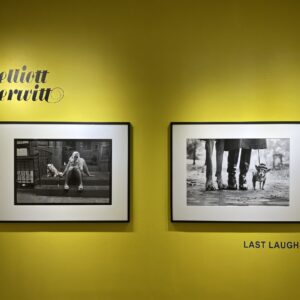JTF (just the facts): A selection of videos and photographs, on view in the main gallery space, the smaller side gallery, and in the reception area. The show includes 16 photographs and 3 video works:
- 5 pigment prints, framed in black/white and unmatted, 2018, sized 40×30, 30×45, or 40×60 inches, in editions of 3
- 11 washi prints, unframed, 2010, 2011, 2012, 2018, all printed in 2018, sized roughly 30×38 or 38×49 inches (or reverse), in editions of 3
- The Park, 2017-2018, digital video, 58 minutes, edition of 5
- Monogram Hunters, 2018, digital video, 26:05 minutes, edition of 5
- Upper Big Tracadie, 2018, digital video, 7:47 minutes, edition of 5
A companion show is on view at the gallery’s Tokyo location (here).
(Installation shots and film stills below.)
Comments/Context: Ari Marcopoulos’ new film The Park is a surprising mediation on the power of understated looking. The idea that the artist could set up a fixed camera on a warm afternoon, document the goings on at a public basketball court near the Walt Whitman housing projects in Brooklyn for nearly an hour, and actually come away with something of aesthetic interest may seem unlikely. But like watching the waves roll in at the beach or staring at a fire as it crackles and burns down, Marcopoulos’ sustained observation of the area around the basketball court shakes off the mundane and quickly becomes entrancing, as the hidden rhythms of life reveal themselves.
On the spectrum of potential urban locations that Marcopoulos might have chosen, this basketball court is an undeniably one of the more bucolic. Warm summer sunshine bathes the scene, leafy trees provide an arched canopy over the playground, and people continually stream by the court, crossing on a paved pathway nearby. As we settle in to watch, an ebb and flow occurs on the court itself, as players listlessly shoot around, form into more formal games of three-on-three, and then wander off, their numbers growing and falling, sometimes down to just one or two easy going jump shooters. While the game swirls in the background, people of all ages and types enter and exit from the sides of the frame, pushing strollers, riding bikes, walking with friends, carrying groceries, striding with purpose, or just getting from one place to another on this lovely day.
Seen from a fixed spot, the scene plays out like a dance performance on a stage. The main group of basketball players provides the central circling movement, mixing momentary improvisation with more repetitive set pieces (defined by the game itself), while new people enter and exit from the wings, further changing the overall dynamics. As more time passes, the speed of the movement speeds up and slows down, with just enough variation to keep our attention. The “choreography”, to the extent there is any, is what becomes mesmerizing – the patterns and repetitions seem to have internal rhythms, even though they are in a sense completely random.
This visual flow is matched by a brilliant improvised piano score by Jason Moran. Apparently the jazz pianist Thelonious Monk used to pull a community center piano out to a nearby basketball court and play while game went on, and Moran has taken that historical tidbit as inspiration for his accompaniment. Moran’s snippets of melody, his patterns and repetitions, and his sense for pacing all seem to lift Marcopoulos’ film up, the everyday movements becoming more harmonious and layered when supported by the music. Just like the sinuous interlocking and reforming connections of the people on-screen, Moran’s notes wander and return, build and collapse, explore and then elaborate, almost like a language. The integrated experience is much more transcendent and moving with Moran’s richly complex accompaniment embellishing (and engaging) the visuals.
While the two shorter video pieces on view in the show don’t match The Park in terms of sophistication or impact, the selection of Marcopoulos’ street images and portraits printed on handmade Japanese washi paper provides a more intriguing foil to the main film. In these photographs, Marcopoulos’ rough snapshot style (complete with numerical date stamping by the camera) is softened by the printing process, turning shadowy spray-painted graffiti into elegant swoops of line. The grace that comes out of that rebellion is unexpected, the textures complementing each other.
There has always been urban rawness and an almost intense unfinished glancing to be found in Marcopoulos’ work, but between The Park and the washi prints, he seems to have let those ideas ferment and mellow a bit. This purposeful slowing down has made the aesthetic more meditative and less combative, the rough edges smoothed into something more atmospheric. The Park asks us to hesitate, and that process of measuring, waiting, and ultimately looking with intimacy and care at the urban life around us is perhaps what Marcopoulos has been trying to get us to do his whole artistic career.
Collector’s POV: The photographs in this show are priced between $12000 and $20000, based on size. The videos are priced between $30000 and $60000. Marcopoulos’ work has little secondary market history, so gallery retail likely remains the best option for those collectors interested in following up.





















Thanks. Inspired me to check out the ‘making of’ video:
https://www.youtube.com/watch?time_continue=11&v=oTsF9Kkbz1A